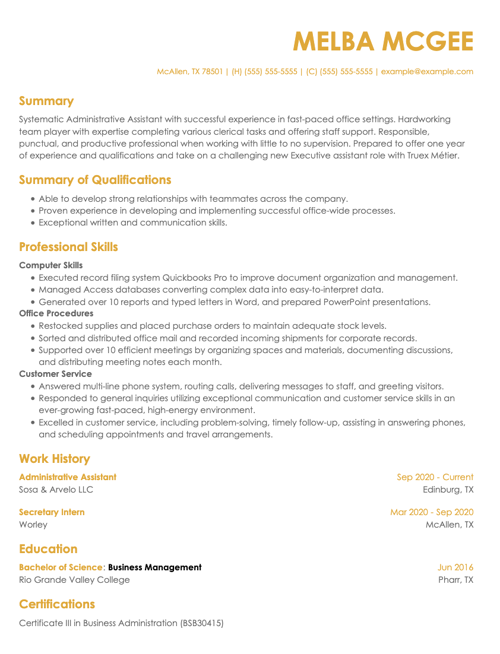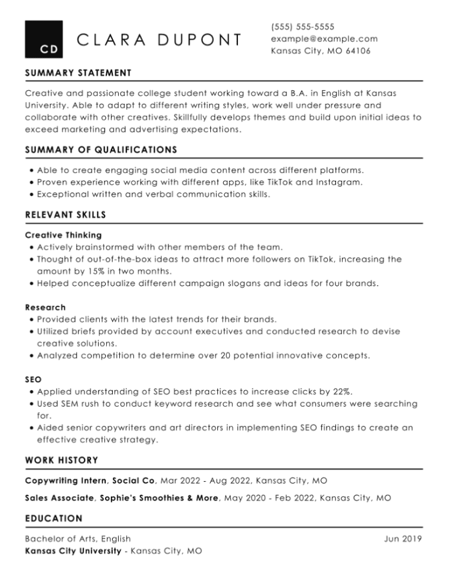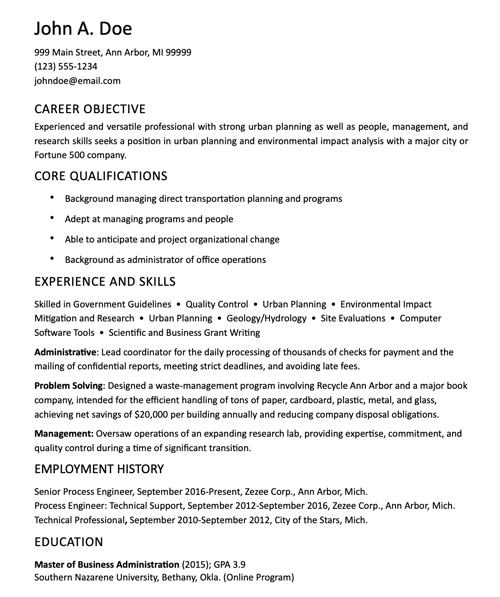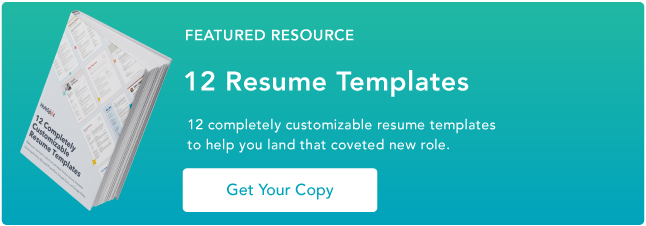Everything You Need to Know About Functional Resumes
Not sure how to make your resume really pop? Wondering how to highlight your skills and experience, despite any possible gaps? You might benefit from a functional resume.

Not sure how to make your resume really pop? Wondering how to highlight your skills and experience, despite any possible gaps? You might benefit from a functional resume. Luckily, this article closely examines everything you need to know about functional resumes, including what they are, when to use them, and the benefits they offer. So, whether you’re new in the workforce, changing careers, or have experienced some time unemployed, a functional resume can help you attract potential employers. Unlike a traditional, chronological resume, a functional resume focuses on your skills and experience — not just your work history. So, instead of focusing on companies, roles, and dates of employment, it groups things like your marketing experience together, presenting a collection of relevant experiences and skills. It’s great if you’re changing careers or have a gap in your work history, as it steers attention away from dates and underscores why you’re a great fit for the role. Plus, functional resumes begin with an objective or summary statement that sets the tone. Then it highlights your skills, accomplishments, and education. The result is a much more targeted, customized resume that reflects your strengths and qualifications. It’s probably clear right now — functional resumes are pretty great. Still, this deserves to be broken down into specifics. Here are the four main, undeniable advantages of functional resumes: When applying for a job, a functional resume highlights skills and accomplishments related to the position. It emphasizes your most relevant skills, even if they weren't acquired in a traditional workplace. Another benefit of a functional resume is that it can help overcome employment gaps. So, for instance, if you’ve taken time off or had a period of unemployment, a functional resume leads with the good, so the gap isn’t as much of a heavy hitter. You can also present your qualifications in a more flexible way with a functional resume. For example, you can group your skills and accomplishments under specific headings, like "project management" or "leadership experience.” It makes it easier for employers to find the relevant bits they’re looking for quickly. Here’s something else a functional resume can do better than the rest: help you stand out. It’s easy to do when basically everyone else is using the standard one. So with a functional resume, you can show that you’re not only willing to try different, innovative approaches but also that you can think creatively. A functional resume is great if you’re looking for a way to underscore skills and accomplishments in a tailored way that fits the role you’re applying for. It considers everything you’ve learned, even in non-traditional formats, making it a genius solution if you have employment gaps. A functional resume may be right for you if you fit into any of these categories: A functional resume highlights your relevant skills, accomplishments, and experiences — even with a limited work history. However, pay close attention to the roles you’re applying for. Functional resumes only work for some applications, so make sure you research the company first before deciding which type of resume to use. Here are three instances where you might want to skip using a functional resume. Some people are just super lucky — and you might be one of them. If you’ve been working consistently in your field, with role after role of relevant jobs and experience building, then you’re better off using a chronological resume. You have the dates, roles, and skills to showcase. You don’t need a functional resume to help you fill in any gaps. With the sheer amount of resumes floating around out there, it’s no wonder some companies use Applicant Tracking Systems (ATS) to filter candidates. However, ATS doesn’t play nice with resumes that don't follow a traditional structure. So, even if you’re more than qualified for a role, the recruiters might never see your resume. Also, keep in mind employer or industry preferences. Some hiring managers prefer traditional resumes, so using a functional format may hurt your chances. Before deciding which format to use, research the company and job posting. It’ll help you tailor your resume to meet their expectations and present you in the best possible light. If you've decided that a functional resume is the best choice for your situation, here's a step-by-step guide to help you create one. Start your resume on the right foot with a summary statement showcasing your skills, qualifications, and experience. It's important to customize this section to the specific job you're applying for so that it provides a brief overview of why you're a great fit for the position. This statement should capture the hiring manager's attention and entice them to continue reading your resume. Once you finish that, the next step is to list the skills you want to emphasize in your resume. This section should showcase your technical and soft skills that are relevant to the job you're applying for. Demonstrating how you have applied these skills in the past helps the hiring manager understand your skills. So highlight your key strengths — it’ll help you show why you’re the best candidate for the job. After identifying your top skills, organize them into clear sections that make sense for your work history and your desired job. For example, you could divide your skills into Technical Skills, Leadership Experience, or Project Management Skills sections. This allows the hiring manager to quickly and easily identify the areas where you excel and can help you stand out as a highly qualified candidate. When detailing your skills within each section of the resume, provide concrete examples of how you've applied those skills in real-life situations. Include specific projects you’ve worked on, notable achievements you've accomplished, or other relevant experiences that demonstrate your proficiency in that particular skill. Even though a functional resume may not focus heavily on your work history, providing a brief overview of your employment background is necessary. You should list your job titles, the names of the companies you worked for, the dates of employment, and a concise description of your responsibilities and notable achievements in each position. Ultimately, it's essential to customize your functional resume to the specific job. So brush up on the role, company, and industry. Then use your research to adjust your summary statement, reorder your skill sections, or incorporate different examples that emphasize the most relevant experiences for each position. By tailoring your resume to the job posting, you can improve your chances of capturing the attention of hiring managers and securing an interview. Here are three functional resume templates to give you an idea of what your own resume could look like. This sample resume from The Balance takes a blended approach to the functional resume. In the “Experience and Skills” section, the applicant shared their past experience relevant to the job posting. A separate “Employment History” section simply includes where they’ve worked in the past and dates. If you don’t have an employment gap and are instead making a pivot, this format can clear up any doubt about your work history. Recruiters can see that you’ve been employed consistently. Best for: Those making a career pivot. In this sample resume, Melba McGee has several opportunities to showcase her skills and explain her qualifications. The summary section at the top of the resume can help her explain reasons for a career change or employment gap. There are also separate sections where she can explain her qualifications and highlight certain skills. What we love: This resume template has a section for certifications. Be sure to list any relevant certifications or coursework you have for a given job. As an intern, you don’t have decades of work experience to pull from. A functional resume can help you highlight your qualifications from your growing professional career. You can also highlight experiences from clubs, classes, and volunteering. What we love: This example resume from Clara Dupont includes specific accomplishments in each skill area. That includes percentages and other statistics related to growth. Using one of these functional resume templates as a starting point, you can create a customized resume highlighting your key skills and achievements and showcasing your value as a candidate. A functional resume is a great way to show off what you're made of as a job candidate. Its format lets you showcase your skills and experience instead of just focusing on where you've worked. With a functional resume, you can prove to employers that you're the right fit for their organization, no matter what your work history looks like. Whether you're fresh out of college, making a career change, or simply looking for a new challenge, a functional resume can help you put your best foot forward. So why not give it a try? With the help of this step-by-step guide, you can create a functional resume that truly sets you apart from the competition. Who knows — it might just be the key to unlocking your dream job.
What is a functional resume?
The Benefits of Functional Resumes
1. Highlights relevant skills and accomplishments.
2. Overcomes employment gaps.
3. Allows for flexibility.
4. Stands out from the crowd.
When to Use a Functional Resume
Limitations of Functional Resumes
Sizable Work History
ATS Compatibility
Employer Preferences
How to Write a Functional Resume
1. Start with a strong summary statement.
2. Identify your key skills.
3. Organize your skills into sections.
4. Provide supporting examples.
5. Include your work history.
6. Tailor your resume to the job posting.
Functional Resume Examples
The Blended Resume
Qualifications and Skills

Intern Resume

Creating Your Own Functional Resume

 Hollif
Hollif ![12 Resume Templates [Free Download]](https://no-cache.hubspot.com/cta/default/53/4ec95757-585e-40cf-9189-6b3885074e98.png)










![What is Clubhouse? [+Should Marketers Care?]](https://blog.hubspot.com/hubfs/what-is-clubhouse.jpg#keepProtocol)




_23.jpg)






.jpg&h=630&w=1200&q=100&v=6e07dc5773&c=1)





![How To Win Brand Visibility in AI Search [Webinar] via @sejournal, @lorenbaker](https://www.searchenginejournal.com/wp-content/uploads/2025/09/2-222.png)






